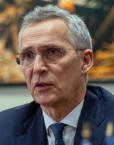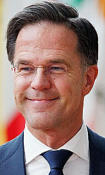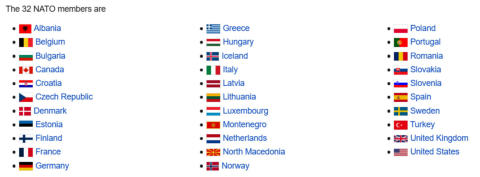

Copyright © Hans Högman 2022-06-21
NATO - North Atlantic
Treaty Organization
NATO
The North Atlantic Treaty Organization (NATO), also
called the North Atlantic Alliance, is an
intergovernmental military
alliance of 32 member states
(2024) – 30 European and
two North American.
NATO's purpose is to
promote and ensure peace
and security in its member
states.
Cooperation is governed by the North Atlantic Treaty,
which was signed on 4 April 1949 and entered into
force on 24 August 1949. The alliance consisted of
the 12 countries that signed and ratified the treaty:
the United States, Belgium, Denmark, France, Iceland,
Italy, Canada, Luxembourg, the Netherlands, Norway,
Portugal, and the United Kingdom. In 1951, the military
organization NATO was established.
NATO's first Secretary-General is Lord Ismay. NATO’s
main headquarters are located in Brussels,
Belgium.
The image above shows the NATO flag.
The basis of the military alliance is governed by the
preamble and 14 articles of the North Atlantic Treaty.
The core of the Treaty is the collective defense clause
in Article 5, which provides that an armed attack on
any of the Member States in Europe or North
America shall be considered an attack on all of them
and that an attacked Member State shall
consequently be assisted by the other members. The
Treaty also describes the principles of ratification,
accession, withdrawal, the establishment of the North
Atlantic Council and assistance in the event of other
threats to the security of Member States.
In 1952, Greece and Turkey joined the alliance. West
Germany was recognized as a sovereign state and
joined NATO in 1955. Spain joined NATO in 1982.
Poland, the Czech Republic and Hungary became the
first Eastern European NATO members in March
1999. In 2004, Bulgaria, Estonia, Latvia, Lithuania,
Romania, Slovakia, and Slovenia joined NATO.
So, in 1999 and 2004 respectively, ten new members
were welcomed, three of which had been part of the
Soviet Union and another six had been part of the
Warsaw Pact. Albania and Croatia joined in 2009,
Montenegro in 2017 and the North Macedonia in 2020.
In 2023, Finland became the 31st member of NATO
and Sweden the 32nd in 2024.
The Alliance’s Names and Official Languages
NATO has two official languages, English and French.
NATO (North Atlantic Treaty Organization) is the
alliance's English name while OTAN (Organisation du
traité de l'Atlantique nord) is its French name.
Structure of NATO
All agencies and organizations of NATO are integrated
into either the civilian administrative or military
executive roles. For the most part they perform roles
and functions that directly or indirectly support the
security role of the alliance as a whole.
Its military assets consist almost exclusively of the
member states' own armed forces, with only a small
number of AWACS aircraft belonging to the NATO
organization itself. The Alliance comprises about 4
000 civilian officials and more than 8 000 staff
officers.
The Civilian Structure
The North Atlantic Council (NAC) is the body which
has effective governance authority and powers of
decision in NATO, consisting of member states'
permanent representatives or representatives at
higher level (ministers of foreign affairs or defence,
or heads of state or government). The NAC convenes
at least once a week and takes decisions on key
policy issues and overall defense planning. Decisions
require unanimity, which gives all members the right
of veto.
The work of the North Atlantic Council is led by the
Secretary General of NATO who is
supported by a staff. Two other
important civilian bodies are directly
linked to the Council.
The image shows NATO's current
(2024) Secretary General, Jens
Stoltenberg.
The Defense Planning Committee (DPC) has a
specific responsibility for joint defense planning.
The Nuclear Planning Group (NPG) was established
in 1967 to give member states greater influence over
nuclear weapons management and deployment.
NATO has no nuclear weapons of its own, with the
majority of the Alliance's warheads belonging to the
United States, and a smaller proportion belonging to
France and the United Kingdom.
The NATO Parliamentary Assembly (NATO PA) is a
body that sets broad strategic goals for NATO, which
meets at two session per year. NATO PA interacts
directly with the parliamentary structures of the
national governments of the member states which
appoint Permanent Members, or ambassadors to
NATO.
The Military Structure
The Military Committee (MC) is NATO's highest
military body, but is subordinate to and advisory to
the North Atlantic Council (NAC). Member countries
are regularly represented by senior military officers
and, more rarely, by their commanders-in-chief
(CHODs).
Instead, the national Chiefs of Defence (CHOD) are
regularly represented in the MC by their permanent
Military Representatives (MilRep), who often are two-
or three-star flag officers.
The MC is led by its chairman, who directs NATO's
military operations.
The Committee and its Chairman are assisted by the
International Military Staff (IMS), which consists of
personnel from all Member States. In addition to its
advisory role, the Military Committee is responsible
for NATO's two strategic commands:
Allied Command Operations (ACO) and Allied
Command Transformation (ACT).
The operational command of ACO is held by the
Supreme Allied Commander Europe (SACEUR),
who, by custom, is always an American general or
admiral who, outside NATO, commands the United
States European Command. In his role as SACEUR, his
headquarters for Allied Command Operations (ACO)
is located at Supreme Headquarters Allied Powers
Europe (SHAPE) outside Mons, Belgium.
NATO member states in 2024



NATOs Three Joint Force Commands
NATO military activities are managed from three
operational headquarters (Joint Force Commands):
Norfolk (United States), Brunssum (Netherlands) and
Naples (Italy).
1.
The Norfolk Joint Force Command is responsible
for defense planning and operations in the North
Atlantic and its associated land area and now also
Scandinavia.
2.
The Brunssum Joint Force Command is
responsible for defense planning and operations
in Germany, Poland and the Baltic States.
3.
The Joint Force Command in Naples has
corresponding responsibility for Southern Europe.
All three Joint Force Commands work closely together
and are governed as a whole by the NATO military
command.
After Sweden joined NATO in March 2024, NATO has
been discussing whether Sweden should be part of
NATO's joint force command in Norfolk in the United
States or Brunssum in the Netherlands.
On July 9, 2024, it is announced that Sweden will be
part of the NATO Joint Force Command in the United
States. However, at this point it is not clear exactly
where the border between the Norfolk Command
and the Netherlands Command will be. The border
may be drawn along the east coast of Sweden. This
would bring Gotland (as well as Åland in Finland and
Bornholm in Denmark) under the military command
of the Netherlands.
All Nordic countries will now belong to the same
military command, Norfolk in North America, which is
good for Nordic defense cooperation.
Secretary General of NATO
The Secretary General is NATO's supreme leader
and the Chairman of the North Atlantic Council. The
Secretary General is the highest position in NATO and
serves as the main representative and spokesperson
of the defense alliance.
NATO's first Secretary General was General Hastings
Ismay (1952 - 1957).
Jens Stoltenberg 2014 - 2024
Norwegian Jens Stoltenberg (b. 1959) was Secretary
General of NATO when Sweden and Finland applied
for NATO membership. He took office as NATO
Secretary General on October 1, 2014. He succeeded
the then Secretary General, the Dane Anders Fogh
Rasmussen (SG 2009 - 2014).
Stoltenberg's appointment was
extended in 2018 and he will serve as
the organization's Secretary General
until 1 October 2024.
Jens Stoltenberg was Prime Minister of
Norway until 2013.
The image shows Jens Stoltenberg,
Secretary General of NATO 2014 - 2024.
Mark Rutte 2024 -
On June 26, 2024, Dutchman Mark Rutte (b. 1967) was
elected as the new Secretary General of NATO. All the
leaders of NATO's 32 member countries endorsed
Mark Rutte, which was required for him to be
approved for the job.
He will officially take office as Secretary
General on October 1, 2024. He will then
succeed Jens Stoltenberg.
Rutte has served as Prime Minister of the
Netherlands since 2010 but left that post
in June 2024.
The image shows Mark Rutte, Secretary
General of NATO from 1 October 2024.

























